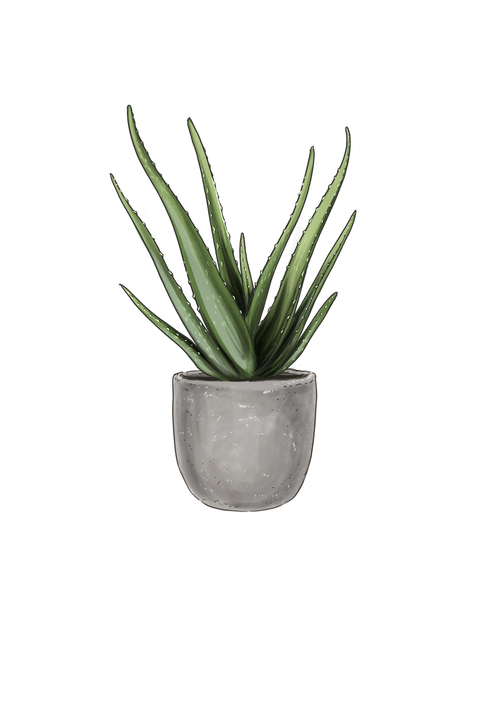Aloe Vera Care Guide

-
Light : High
Indoors: Bright, indirect light in a southern or western exposure window. Outdoors: Set in bright indirect light or 2-4 hours of morning sun and afternoon shade where temperatures are above 45°F at night.
-
Water : Low
Water your Aloe vera when the soil is dry on your moisture meter. Check the moisture every two weeks in the summer and every four weeks in the winter. Use filtered, bottled, or tap water that has been sitting 24 hours to release the chemicals. Take the plant out of your decorative container and water enough to discharge out of the drainage holes. Allow the plant to absorb the excess water for 15 minutes in a tray and then remove the excess water and allow them to finish draining. Once the water is fully drained, replace it into the cache or decorative pot. Allow your Aloe Vera plant to dry out between waterings and rotate your plant one quarter turn each time you water for consistent indirect sunlight exposure.
-
Humidity : Low
The Aloe vera plant doesn't need any extra humidity.
-
Temp : 60℉ - 75℉
Average comfortable room temperatures will be sufficient. These plants do not like cold termperatures under 45°F.
-
Zone : 8|9|10|11
This Aloe plant can thrive in full sun for at least 6-8 hours per day or a brightly covered area where temperatures are above 45°F at night.
-
Fertilizer : Yearly
Your Aloe vera is very self-sufficient. If you must, once a year in the spring, fertilize it with a balanced indoor plant fertilizer at half strength.
-
Repotting : 2 Years
When receiving the Aloe vera, do not repot immediately but wait at least 6-12 months. Repot every two to three years or when the roots are beginning to get crowded and growing through the drainage holes.
Repot in the spring, using a 2 inches bigger pot with drainage holes to keep the roots drier.
Place a piece of screening at the bottom of the container over the drainage hole to secure the soil and allow it to drain. Use cacti and succulent potting mix or an aerated soil mixture to prevent any root rot in this indoor plant.
Add the soil mix to the bottom to elevate the root ball. Lift the plant and release the roots against the existing planter. Use a clean knife or garden trowel to wedge between the pot and the soil to loosen.
Inspect the root ball. Notice if there are any dead or rotting roots and trim off with sterile pruners. If the plant is rootbound, cut through the roots to alleviate continued encircling.
Ensure the plant is sitting about 1 inch below the edge of the pot to avoid water spillage. Add more soil and backfill around the sides by tamping down. Fill up to the soil line but not over.
Water thoroughly, and let the pot drain. If settling occurs, add more soil.
-
Cleaning : Monthly
With a sterilized knife or pruners, you can cut off spent flower stalks at the base of the stem to groom the plant if being grown outside. To harvest a leaf for medicinal purposes or cleaning, cut the leaf at the bottom of the plant nearest to the main branch.
-
Propagation : Cuttings
Remove offshoots from the Aloe vera plant to start a new plant. The offsets are attached to the mother plant below the soil's surface. Remove the soil down to where they're connected. Then, separate them with scissors or a sterilized sharp knife. Leave a little piece of the stem on the new Aloe. Sit these new offsets out in the air for several days to callous over the wound. This action will help prevent root rot when repotting. Keep them in a warm, dry place out of direct sunlight while they heal over. Next, pot them in a cactus and succulent potting mix to help with aeration and drainage. Put in an indirect, brightly lit spot on the southern or eastern exposure of your home. Wait a week before watering your newly potted offshoots.













